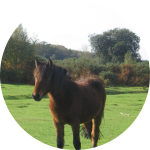|
During the twentieth century, representational paintings
of horses became increasingly the domain of "horse painters"
such as Richard Stone Reeves (1919-2005). The New York City-born
artist is, himself, representational of this genre of painting.
Growing up near Belmont Park, Reeves came by his love of horses
and Thoroughbred horse racing early; he stayed close to home,
studying fine arts at Syracuse University, and a portrait
of 1947 Horse of the Year, Armed, made his name when it featured
in Life Magazine that year. His favorite horses to paint included
Buckpasser, Secretariat, and Affirmed. His thoroughness in
painting Thoroughbreds and love of the world of racing got
him named the greatest modern horse painter by no less an
authority than Blood Horse Magazine.
Outside the world of horse painting, though, horses continue
to exert a strong appeal as subject, symbol, or suggestion
to modern artists and writers. The most famous example, perhaps,
is Pablo Picasso's Guernica (1937), the artist's enraged response
to the Nazi bombing of Guernica, Spain. Already commissioned
by the left-wing Spanish Republican government to paint a
mural representing Spain at the 1937 World's Fair, Picasso
revised this massive work, on which he'd already been at work
for several years, to reflect the devastation of the unprovoked
Nazi attack.
What had been a simple bullfighting scene became a gray fury
of grieving mothers, dismembered soldiers, and, in the painting's
center, a horse fallen by a javelin. (The horse's nose and
upper teeth double as a human skull-shape.) The painting had
a second life when, with the fall of the Republicans to the
fascist Francisco Franco, it was sent to the United States
to raise support for Spanish refugees fleeing what was to
be a decades-long reign of terror. For much of the twentieth
century (until a post-Franco Spain won it back in 1981), the
painting hung at the Museum of Modern Art in New York, where
it was the site of many Vietnam-era anti-war vigils. (In one
of these, some idiot named Tony Shafrazi defaced the painting
with red spray paint. Way to win support for your cause, smart
guy.)
It now hangs in the Museo Nacional Centro de Arte Reina Sofia
in Madrid. A replica is displayed near the entrance to the
Security Council meeting room at the UN building in New York,
where - I am not making this up - it was briefly covered up
at the behest of the Bush Administration during a 2003 press
conference to drum up support for the proposed venture in
Iraq. The painting, it seems, has retained its potency.
At the end of Andrei Rublev (1966) - the Russian director
Andrei Tarkovsky's massive biopic of the medieval Russian
icon painter - the black-and-white picture bursts into color,
and we see details from several of Rublev's most famous icons,
followed by an enigmatic, perfectly framed image of four horses
rolling in a river during rain. With its suggestion of freedom
and abandon, this image is a fitting conclusion to a film
regularly hailed by critics as one of the world's greatest
- a gorgeous visual hymn to the freedoms of art, made in a
culture so reactionary that the film wasn't released in the
USSR until 1971. Though the entire film is image-rich, many
viewers remember this equestrian coda the best.
Horses play a role - surprisingly enough - in the birth of
American punk rock, too. Patti Smith, a poet and songwriter,
was a New York City cult figure in the early 1970s, playing
frequently to modish audiences at CBGBs, where she forged
relationships with such innovative bands as the Ramones, Talking
Heads, Blondie, Richard Hell's Voidoids, and Television, whose
legendary guitarist Tom Verlaine was her sometime boyfriend.
These bands had little in common except a commitment to stripped-down
rock (influenced by the garage bands of the 1960s) played
with a sort of post-Warhol self-consciousness. But Patti Smith's
band were the first to cross over to a mainstream record company,
releasing their first album, Horses, on Arista in 1975.
Over a churning background that often suggested both the Troggs's
"Wild Thing" and the wild sax solos of John Coltrane, Smith
sang and chanted her obscure, imagistic lyrics, strongly influenced
by 19th-century French poetry and the Beats. The album in
turn influenced REM, the Smiths, the Libertines, Bruce Springsteen,
and many other artists, while paving the way for a gruff yet
sensitive female presence in rock that would prove important
to such disparate performers as Tori Amos, Sinead O'Connor
and the Cranberries. No one who hears the album forgets Smith's
urgency as she repeats the line, "Horses ... Horses ... Horses
..."
About the Author
TRP Services
offers Thoroughbred horse racing and horse racing tips online
for horse racing handicapping and those who love thoroughbred
horses for the horse racing tracks.
|


